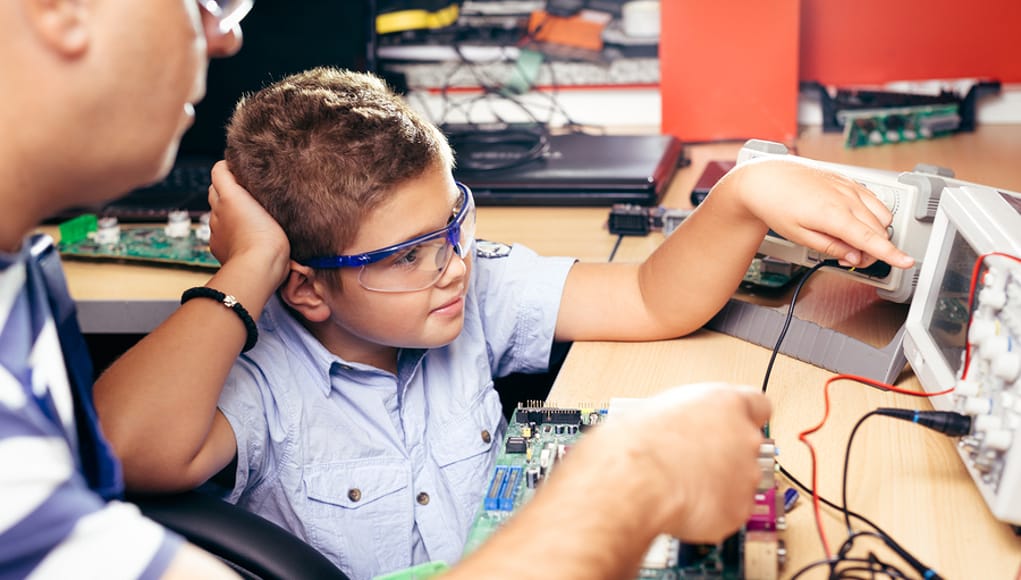How to Introduce your School to STEM: The 5 Most Important Factors for Success

Does STEM scare you?
It scared me for a long time. I was that guy who put IKEA furniture together… backwards. When the oil light came on in the old Pontiac 6000 I used to drive, I thought it meant the car needed more gas.
I recently found myself at the helm of a Montessori Elementary schools’ new STEM program. Needless to say, I felt like a fish out of water. But as is the case with any new project I take on, I have realized, success is about 0.5% due to me and 99.5% the result of the team I put in place around me. Fortunately, I have two brilliant team members – one, a hippie science whiz who would give Bill Nye a run for his money and another, an easygoing, affable Canadian who could probably figure out how to reassemble a computer having never seen the inside of a CPU.
Together, we have slowly introduced STEM to elementary students within our brand new MakerSpace. And while it’s been slow going and we have made TONS of mistakes along the way, I believe we are starting to gain traction.
If you are new to STEM or are trying to figure out how to maximize the use of your new MakerSpace, here are five things to consider:
Make it Fun
Like most educators, we started our STEM projects with way too many guidelines. Our first project had rubrics, journal prompts, criteria(s) for success, timelines and multiple feedback sessions. And while we thought this would signal to kids and teachers that we had it all together, in reality, it told students that this was OUR project, not THEIRS. We learned. Our second project had far fewer parameters and allowed students to explore.
Make it Short
A good STEM project is like a short roller coaster ride at your favorite amusement park.
It throws you around a few turns, has one to two unexpected surprises and provides a finale just as you are hoping there is more. STEM projects should get kids creating things—fast. Have students build birdhouses, feeders for the visiting birds. Let them build a simple toy out of a motor and a switch. Let them exhibit what they create with their peers. This will build confidence in your students and leave them begging for more.
Make it Collaborative
Get students involved early and often. Our second project-building, a habitat for a younger years’ class pet, provided students total freedom in their design for their furry friends. They were able to choose what animal they would build for, what materials they would use and how they would divide roles and tasks. Providing them with this freedom allowed them ownership of the project, resulting in better outcomes and increased engagement throughout the process.
Make it Manageable
Although it’s ambitious to ask students to solve the global waste problem, it’s much more manageable to ask them to address the plastic problem in their local bay. It allows you as the STEM instructor to source appropriate materials, scaffold mini-lessons and create partnerships with other schools and organizations involved in this work within the community. This place-based learning approach to learning allows students to dive deep and extend curriculum that can’t be delivered in the same way within the school walls.
Make it Visible
There’s a famous TED video that shows a random guy dancing in the park. After about five minutes of uninhibited dancing, another sun bather joins him. Pretty soon, the entire park joins in on the fun. The purpose of the video was to demonstrate ‘how you start a movement.’ The same lesson can be applied when developing your STEM program or MakerSpace. In our case, we organized a simple ‘STEM Fair.’ Students across the school were invited to sign up and deliver an experiment to share with other classes. As was the case with the random dancer, initially, only the bravest students signed up. But as the date for the fair approached, more students gained in confidence. By the day of the fair, we had to close signups because there was no room left to exhibit.
The Takeaway
STEM can be scary, but it also provides us with incredible opportunities. It allows us to create makers, tinkerers, creators, scientists and explorers. It helps us cultivate and build skills with learners that will be necessary as we look at jobs of the future. By making STEM fun, short, collaborative, manageable and highly visible, you will watch your students transform daily.
For more, see:
- How to Teach STEM Without Being an Engineer
- How to Generate Interest in STEM Fields in Early Elementary Students
- All About STEM High Schools
Stay in-the-know with innovations in learning by signing up for the weekly Smart Update.








Mindy Jollie
I like what you said about making STEM projects fun for elementary schoolers. I would imagine that interactivity plays a big role in that. My children are looking forward to a STEM assembly at their school, and I'm sure they'll incorporate a lot of those ideas.